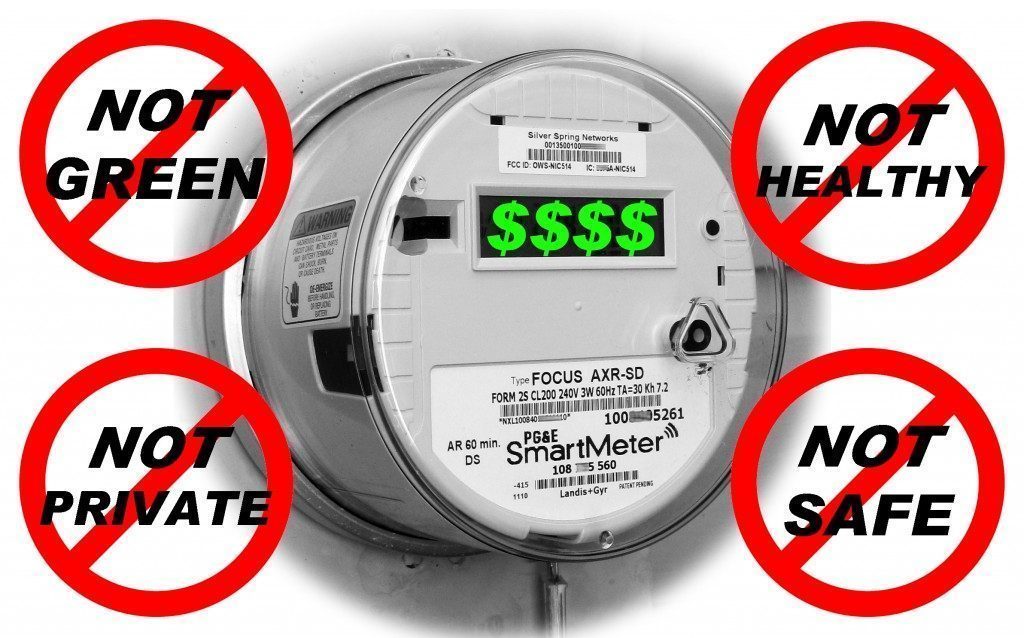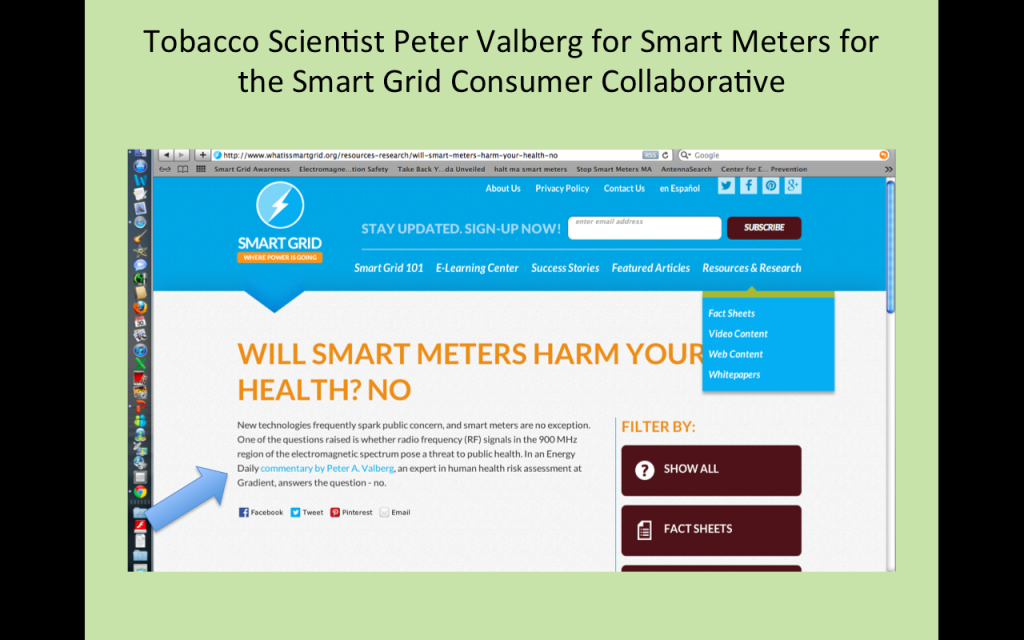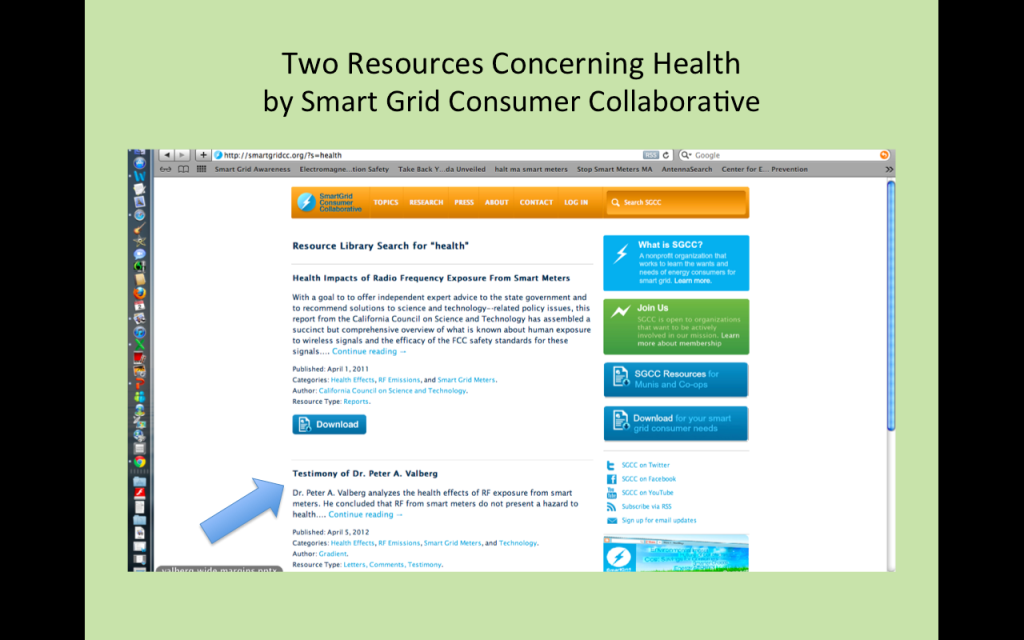A few years back, the deployment of wireless smart utility meters and smart grids was “sold” to the public, especially environmentalists, in part in order to integrate renewables (DERs, Distributed Energy Resources) into the electric grid. [1]
Against the backdrop of the industry jargon of “robust architecture;” “stakeholders” that did not include actual customers; and my personal favorite: “the health of the ecosystem,” earnest supporters of renewable energy went along with the story that if utilities were allowed to surcharge ratepayers to place a system of wireless controls and sensors onto the grid and into people’s homes, that solar energy would be integrated into the grid. This would reduce reliance on fossil fuels and lower our carbon footprint.
Only, it didn’t exactly work out that way.
State after state established rate structures and fees that do not support solar,[2],[3] with the two most recent actions (April, 2017) in Maine[4] after smart meters were deployed, and in South Carolina. [5]
As Bill Ellard explained in his 2107 3-part series “Solar Wars” in Solar Today Magazine,
Before 2012 utilities in the USA had no reason to see solar as a threat to them, as the amount of revenue lost to customer self-generation was extremely small. So during this timeframe, utilities did not mind giving customers full retail credit for their excess energy.
Net-metering typically occurs between 10 am and 4 pm when a customer’s solar system is producing more electricity than the onsite loads require: the sun is shining and the occupants are off at work. This “extra” energy is sent back through the utility-owned meter and into the grid; typically, it amounts to about 20-30% of the electricity produced by the solar system.
Net-metering means full retail credit for one’s excess energy; your bill would have it energy usage reduced, and if your usage goes negative, then you get a rollover credit for you next month’s bill. The battle is about the utilities wanting to change this credit on customers’ bills so that it’s lower than the retail rate of electricity. This has started discussions about the concept of “the value of solar” for utilities in many states.[6]
A recent study conducted in Montana by third-party consultant Navigant demonstrates the utility company’s view:
In a 40-page cost-benefit analysis of solar net metering, Montana’s largest utility company concluded that the energy rooftop solar delivered back onto the grid had a net value of about 4 cents per kilowatt hour. That’s about a third of what net-metering customers are currently compensated. The 2017 Montana Legislature ordered the study to determine whether the costs of accommodating net-meterers were being unfairly distributed to other customers. A possible result of the study was that people delivering rooftop solar back onto the grid would have to pay more for the ability to do so, most likely by receiving less credit for the surplus power sold back to NorthWestern. [7]
In addition to changing the compensation formula for solar producers, utilities, politicians, and regulators are also approving demand charges, where the customer is surcharged for the entire month based on the period of time when they draw the most electricity. For example, Massachusetts has approved demand charges for Eversource’s net-metered customers.[8],[9]
The idea of demand charges appeals to gas pipeline and fracking opponents who want to curtail the use of gas-powered peaker plants. As communities across the country rise up to oppose gas pipelines, a new justification for smart meters is emerging: using time-of-use pricing to reduce peak loads. Those who oppose gas infrastructure due to adverse environmental, health, and property value concerns are expressing a willingness to change the time that they use electricity, according to a new report by the Smart Energy Consumer Collaborative.[10]
Translated into real-life terms, this means that a senior citizen with a once-a-week home-health-aid who does the dishes, vacuums, and does the laundry will face an enormous financial penalty, vs. a 2-income family charging their electric vehicle at night and placing an override switch on their pool pump. Meanwhile, large corporations move to install private solar with storage for grid defection.
There are also numerous campaigns underway to quantify the costs of air pollution from dirty power, as opposed to “clean” power, for example, in childhood asthma rates, especially in economic justice communities, in order to justify increased investment in “clean” energy, as opposed to burning polluting fossil fuels.[11], [12]
Leading “environmental” organizations like the National Resources Defense Council and the Environmental Defense Fund are in favor of wireless smart meters and clean energy and have testified in many state proceedings.
So, what’s not to like?
Utilities are succeeding in convincing customers that they want a smarter grid.
The belief that more data, more technology, and more innovation is the solution to the planet’s problems is crashing up against the reality that another wave of planetary damage is being fueled by the very people who believe that they are doing the right thing. And, if that group were to re-align their actions with their objectives, maybe, just maybe, we could turn this thing around.
Let’s unpack a few simple clarifications in support of the approaching Earth Day observance.
1 – Wireless technologies and the cloud are energy hogs. Even though it is invisible, the cost of energy consumed of collecting, transmitting, analyzing, and storing all of the data has a carbon footprint.[13] Entitlement and an attitude of manifest destiny about wireless connectivity and data mining is increasing record energy consumption. Issues regarding conflict minerals, e-waste, property values, and human rights abuses are being ignored in favor of economic growth. There is a massive unacknowledged cost for planetary resources required for the infrastructure build-out for the planned 5G Internet of Things 4th industrial revolution. We have no evidence that 5G will be any less damaging than previous waves of environmental destruction.
2 – It is possible for a thoughtful and informed environmentalist to favor solar energy and other distributed resources, and not endorse the rollout of a wireless grid that doubles as part of a surveillance network as well as a source for monetizing private data. Solar energy does not need to be grid tied, and larger companies are defecting already. It is possible to oppose gas and nuclear infrastructure and not to endorse another form of damaging infrastructure.
3 – A logical policy would be to require any new technology deployed to address the health and environmental consequences of the fossil fuel model to be pre-market tested for health and environmental effects, rather than believing that every damaging wind or snow-storm provides more impetus for rushing to justify more untested and un-monitored wireless infrastructure investment. The renewable energy community has the right and the responsibility to ensure that the wireless industry is not endangering human health and the environment, or the viability of their businesses.
4 – We have not escaped the damage caused by organizations like the infamous Tobacco Institute and the Council for Tobacco Research. We must choose our experts very carefully. The Smart Energy Consumer Collaborative contains no consumers, and even the name change cannot alter the group’s history of relying on tobacco scientist Peter Valberg as the industry smart meter health expert. The Collaborative’s members are utilities and their economic partners, including regulators. It is a trade group operating under a non-profit umbrella to produce justification for monopoly utility industry interests.
5 – Navigant is the “third party analyst” that performed the study for Montana utilities, concluding that they are being short-changed by the solar net-metering compensation formula. This is the same Navigant that was identified in an email chain out of California by PG&E’s Marzia Zafar as a pro-industry resource, assisting utilities in denying issues that were emerging with smart meters, in 2010. [14]
6 – Navigant is also the firm that created the final report for the Worcester National Grid smart meter pilot program, On August 9, 2017, the Telegram and Gazette published, “Worcester Cited As Example of Power Grid That Isn’t Stupid” by Andy Metzger of Statehouse News Service. [15] “If your power goes off at your house, the only way we’d know right now is if you pick up the phone and call us,” National Grid Massachusetts President Marcy Reed told policy-makers from around the country…. “A lot of people just assume in this day of technology, of course we must know. Well, we don’t. It’s a dumb grid.” “The exception is Worcester, where Reed said a pilot modernization project has allowed 11,000 customers to save $1.8 million over the last year of the pilot.” “Reed said that in Worcester, National Grid offered customers the ability to opt out of the pilot and only about 2 percent opted out.” [16]
The $45M Worcester smart meter pilot program which ballooned to $60M shrank from 15,000 to 11,000 customers after at least 16,000 smart meter installations, rendering the 2% drop-out rate claim misleading at best, if not fraudulent. At the same time, the reported cost rose to $60M, possibly to be borne by ratepayers. (MA DPU 17-53) The auto-enroll pilot included free equipment such as pool pump override switches, Dunkin’ Donuts gift cards and iPad prizes. It bears no resemblance to any smart meter deployment to date. The question is not whether the grid is “dumb.” The question is “Why is fraudulent math being reported out of Worcester, Massachusetts? As Clare Donagen asked, How dumb do they think we are? The pilot program exemplifies the profound danger of unchecked data misuse and abuse.
7 – Why have clean energy groups failed to scrutinize the wireless industry? Environmental Groups including (EDF[17], and NRDC[18]) have not responded to evidence from citizens that the smart meter rollout is fraught with issues of integrity, nor has the American Cancer Society. However, the AARP in Michigan attempted to defend citizens from utility overreach and abuse.[19]
8 – We have countless examples of industries that have suppressed evidence of harm in favor of profits for decades. We are already decades in to denial by the wireless industry. [20]
9 – Real people have been and are being hurt by wireless and utility infrastructure.[21]
And today, there are signs of hope.
In addition to the scientists of integrity working on the NTP[22] and Ramazzini[23] studies on radiofrequency exposure and cancer, as reported by Arthur Firstenberg of the Cellular Phone Task Force, in New Mexico, the Public Regulation Commission has denied PNM’s application for Smart Meters this week. “The plan presented in the Application does not provide a net public benefit and it does not promote the public interest,” wrote the Commission.[24]
The Commission accepted the Hearing Examiner’s recommended decision without alteration. It ruled that:
• PNM did not demonstrate that smart meters will save money.
• PNM did not demonstrate that smart meters will produce energy efficiency.
• PNM did not show that customers want smart meters.
• PNM did not evaluate alternatives.
• PNM did not say how it would protect customer data privacy.
• Cybersecurity issues need to be addressed.
• 125 good, high-paying jobs would be lost.
• Proposed opt-out fees were unreasonable.
• There was insufficient public input.
• There was insufficient response by PNM to public objections.
EVIDENCE ABOUT HEALTH EFFECTS was discussed at length.
Customers who have strong feelings about the health effects of the meters should be allowed to protect their stated health concerns without a prohibitively high cost.
The decision goes on to state:
The conditions of the portion of the population who believe they are electromagnetically sensitive deserve acknowledgment and consideration as decisions are made regarding the implementation of an AMI Project. Accommodations could include reasonable opt-out provisions and fees and perhaps the selection of technologies that minimize the impacts on such people. Such accommodations may be desirable to minimize health risks to customers and address the needs and preferences of PNM’s customers. These are issues that can and should be addressed in a public input process of the sort PNM stated in its 2012 Report that it would conduct before bringing a smart meter proposal to the Commission for approval.
There has been no independent investigation of reported health damages by wireless utility infrastructure including smart meters in the U.S.
And, despite reductions in the electricity sector, the U.S. has made no progress in lowering its carbon footprint.[25]
We could start to turn this runaway train around in New Mexico, by breaking up the marriage between solar and wireless meters and infrastructure.
Solar companies could integrate building biology into the industry, and help guide federal energy polity towards recognition of variables like shielding and filtering, cleaner inverters, power quality, and dirty electricity health issues.
Bill Ellard wrote in Solar Today,
In my opinion within a few years, all residential solar installations will have storage, smart inverter, and curtailment control. In this case with no electricity being passed to the utilities equipment and grid, customers will not even need to notify their utility of their new solar system – or ask for “approval.”
And hopefully, no one will be begging for his or her life anymore, because of a meter.[26]
We need strong industries willing to stand apart from the domination of the economy by wireless and big tech, comprised of individuals not willing to lie, mislead, or ignore harm. We can do better.
Notes:
[1] Smart meters the way to a new age of clean energy
https://theecologist.org/2017/apr/03/smart-meters-way-new-age-clean-energy
[2] Nevada’s perplexing war on solar
https://www.cnn.com/2016/02/06/opinions/sutter-nevada-solar/index.html
[3] Solar Wars
There will be three battles in this war: net-metering, tariff reform, and grid defection.
https://www.ases.org/solar-wars-part-1/
https://www.ases.org/solar-wars-part-2/
https://www.ases.org/solar-wars/
[4] Bill to boost solar energy industry dies again in Maine House
http://bangordailynews.com/2018/04/10/politics/bill-to-boost-solar-energy-industry-dies-again-in-maine-house/
[5] South Carolina House kills pro-solar bill after last-minute rule change
https://www.postandcourier.com/politics/south-carolina-house-kills-pro-solar-bill-after-last-minute/article_b1035912-3cff-11e8-9495-270561684fa0.html
[6] https://www.ases.org/solar-wars-part-1/
https://www.ases.org/solar-wars-part-2/
https://www.ases.org/solar-wars/
[7] Montana’s largest utility overpays for rooftop solar energy, study suggests
http://helenair.com/news/state-and-regional/montana/montana-s-largest-utility-overpays-for-rooftop-solar-energy-study/article_ff19481a-432a-5f9b-9907-1fab63b1f980.html
[8] Massachusetts approves new demand charge for Eversource’s net metering customers
https://www.utilitydive.com/news/massachusetts-approves-new-demand-charge-for-eversources-net-metering-cust/514477/
[9] http://170.63.40.34/DPU/FileRoomAPI/api/Attachments/Get/?path=17-05%2f1705B_Order_1518.pdf
[10] Three things consumers want from electricity providers
Utilities are working to improve the customer experience, but what do consumers really want? Smart Energy Consumer Collaborative’s Patty Durand explores.
While interest is not quite as high as clean energy investments and energy data programs, our research did find that a majority of consumers are interested in programs that encourage and reward them for reducing or shifting their electricity usage during periods of high demand. The aforementioned “Consumer Pulse” study, for example, found that 59 percent of U.S. consumers were either “probably interested” or “definitely interested” in participating in such a program. Again, with millennials, we see a slightly higher trend here. https://www.utilitydive.com/news/three-things-consumers-want-from-electricity-providers-1/520821/
[11] Health Costs of Fossil Fuels
https://citizensclimatelobby.org/laser-talks/health-costs/
Fossil fuel subsidies are dwarfed by health cost
https://climatenewsnetwork.net/22809-2/
[12] The High Cost of Fossil Fuels Fossil fuels are a leading source of air and water pollution. The economic cost of air pollution in sectors regulated under the Clean Air Act has been estimated at $9 trillion between 1970 and 2000, with costs resulting from pollution-induced early mortality, illness, health care costs and lost productivity. https://environmentamerica.org/reports/ame/high-cost-fossil-fuels
[13] http://science.time.com/2013/08/14/power-drain-the-digital-cloud-is-using-more-energy-than-you-think/
[14] From: Zafar, Marzia Sent: 7/30/2010 11:18:26 AM
To: Lokey, Felecia K (/0=PG&E/0U=C0RP0RATE/CN=RECIPIENTS/CN=FKL3); Dietz, Sidney (/0=PG&E/OU=Corporate/cn=Recipients/cn=SBD4); Devereaux,William (/0=PG&E/0U=C0RP0RATE/CN=RECIPIENTS/CN=WFD4)
Subject: FW: Texas PUC – Smart Meter Evaluation Completed. Results Attached
From: Zafar, Marzia Sent: Friday, July 30, 2010 11:14 AM
Subject: Texas PUC – Smart Meter Evaluation Completed. Results Attached
Hello, This morning at the Texas PUC’s Commission meeting Navigant Consulting gave the three Commissioners a summary of their evaluation of smart meters. Navigant operates in a similar capacity as Structure Group for us.
ftp://ftp2.cpuc.ca.gov/PG&E20150130ResponseToA1312012Ruling/2010/07/SB_G T&S_0650931.pdf
[15] http://www.telegram.com/news/20170809/worcester-cited-as-example-of-power-grid-that-isnt-stupid
[16] http://170.63.40.34/DPU/FileRoomAPI/api/Attachments/Get/?path=10-82%2fSES_Final_Evaluatio_Report_Cus.pdf Note that the 2017 report was posted under a 2010 docket by the Massachusetts Department of Public Utilities.
[17] EDF: Environmental Innovation Will Transform Business as Usual “Yet currently missing from all of this corporate sustainability leadership guidance is a call for companies to accelerate environmental innovation and deployment of next generation technology—sensors, AI, data analytics and visualization, and digital collaboration—to solve our most pressing environmental challenges.”
https://www.ecowatch.com/environment-business-sustainability-edf-2554760634.html/
[18] NRDC: https://www.nrdc.org/sites/default/files/smart-grid-IB.pdf
[19] http://gophouse.org/glenn-smart-meter-bill-top-10-priority-aarp/
[20] http://www.magdahavas.com/category/from-zorys-archive/
[21] https://smartgridawareness.org/2014/12/07/symptom-development-from-smart-meter-rf-exposure/
[22] Can your cellphone cause cancer? Scientists find definitive link in study of rats.
[23] http://microwavenews.com/news-center/ramazzinis-belpoggi-interview
[24] http://smartmeterharm.org/2018/04/11/breaking-new-mexico-rejects-pnm-smart-meter-proposal/
[25] The US is winning the climate fight in electricity — and losing it just about everywhere else https://www.vox.com/energy-and-environment/2018/4/10/17214446/climate-fight-electricity
[26] https://alamedasun.com/news/smart-meter-activist-arrested-blockage
Patricia Burke works with activists across the country and internationally calling for new biologically-based microwave radio frequency exposure limits. She is based in Massachusetts and can be reached at stopsmartmetersMASS@gmail.com.




Frankly,I would rather go back to the “Little House on the Prairie “days